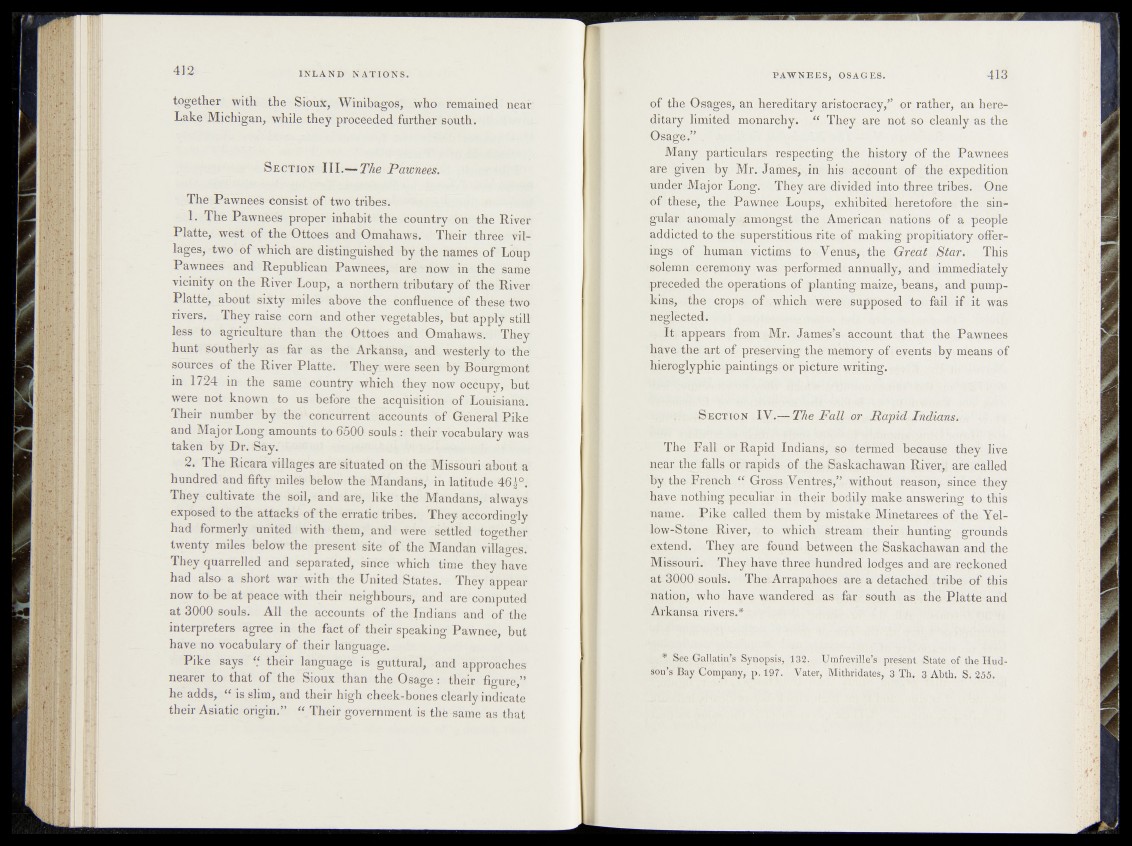
together with the Sioux, Winibagos, who remained near
Lake Michigan, while they proceeded further south.
S e c t io n III.— The Pawnees.
The Pawnees consist of two tribes.
1. The Pawnees proper inhabit the country on the River
Platte, west of the Ottoes and Omahaws. Their three tillages,
-two of which are distinguished by the names of Loup
Pawnees and Republican Pawnees, areS now in the same
vicinity on the River-Loup, a northern tributary of the River
Platte, about sixty miles above the confluence of these two
rivers. They raise corn and other vegetables, but apply still
less to agriculture than the Ottoes and Omahaws, They
hunt southerly as far as the Arkahsa, and westerly to the
sources of the River Platte. They, were seen by 5Hjj|pS&Siat
in 1724 in the same country which they now occupy, but
were not known to us before the acquisition of Louisiana.
Their number by the concurrent accounts of General Pike
and Major Long amounts to 6500 souls: their vocabulary was
taken by Dr. Say.
2. The Ricara villages are situated on the Missouri about a
hundred and fifty miles below the Mandans,' in latitude *46|Ai
They cultivate the soil, and are, like the Mandans,; always-
exposed to the attacks of the erratic tribes. They accordingly
had formerly united with-them, and- Were settled together
twenty miles below the present site of the Mandan villages.
They quarrelled and separated, since which time they have
had also- a short war with the United States. They appear
now to be at peace with their neighbours, and are computed
at 3000 souls. All the accounts of the Indians and of the
interpreters agree in the fact of their speaking Pawnee, but
have no vocabulary of their language..
Pike says “ their language is guttural, and approaches
nearer to that of the Sioux than the Osage: their figure,”
he adds, “ is slim, and their high cheek-bones clearly indicate
their Asiatic origin.” “ Their government is the-same as that
of the Osages, an hereditary aristocracy.;” or rather, an hereditary
limited monarchy. “ They are not,so cleanly as the
Osage.” .
Many particulars respecting the history of the Pawnees
are given by Mr. Jamev,in. his? account of the expedition
under-Major Long. They are- divided '’i®#0|three tribes. One
of these, the Pawnee* Loups,' exhibited! heretofore- the singular
anomaly «nmongst-s sthie 4 American nations ofe a ‘people
addicted to the,1 superstitious rite of making propitiatory .ofier-
?i^gS of human ,vietijms-.,to',Yenus,.the;<G!r^aif.l^ay., This
^ jem n ceremony was, performed:, annually, and immediately
preceded the operations,of planting, maize, beans, and pumpkins,
the crops of .which* were, .supposed to fail if it was
neglected.
It appears from. ;-Mr. .James's*-account that the Pawnees
havnlhe art of preserving the memory ori events by-Uieans of
hieroglyphic paintings, or-picture writing. ,,-
S ection IV.— The F.all or Rapid* fndians.*;.
The Fall pr Rapid Indians,' so-'termed because they live
near the-falls or rapids,;-pf .the Saskachawan Rivei&f are-Cafled
by the French “ Gross Ventres,” -without.,reason^- sitfce'they
hafpnothing peculiar-in^heir bodily make answering, to this
name.. Pike called them by mistake Minetarees;Qf the.Yellow
Stone River, , to which i,stream- their-shunting -grounds
extend. They are found between |iife§ a sk a# aw ^
Missouri. They have three hundred; lodges- and are reckoned
at 3;@00 souls. ThetoArrapahoes, are a detached Jribe0 of this
nation, who have wandered as ,far south, as.,the Platte and
Arkansa rivers.* *
, * See Gallatin's SynopsjsJ;132., p^ese!pt,Stat§,of the Hudson’s
Bay Company, p . i ^ . Vater, Mithridatgs, 3 Th. 3 Abth. S. 255.